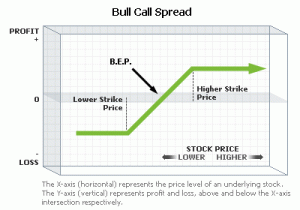Markets had run up almost 10% in fast 12 trading sessions and now most of people are confused whether to Buy Call or Puts.
I here by discuss few Option Strategy which can come Handy in this type of market.
Generally these combination strategies are used primarily in case of two scenarios, one when you are moderately
bullish on the stock or index under consideration, or two when the IVs (Implied volatility) of the options used for
constructing the spread are too high.
Bull Call Spread:
As we mentioned earlier the strategy is chosen when the stock is expected to move higher and the upside is expected
to be limited.
The Position is created by purchasing a call (preferably At-the-money or slightly Out-of-the-money) and selling another
call at a higher strike price (preferably near to the target price) with the same expiration (same month) for a net debit.
Here the credit received from the Short call subsidizes the cost of the Long call, and the profit is limited in exchange
for reduced risk.
Maximum Risk: Limited to the Initial Net Debit Paid
Maximum Profit: Limited to the difference between Strikes minus initial debit paid.
Breakeven Price: Long (lower) Call Strike + Initial Debit Paid.
Let us consider this illustration;
We are currently Bullish on the Nifty which trades at 6000 and we expect it to show an upside of say 200 odd points. We buy a October 6000 Call at Rs.170 and Sell a July 6200 Call at Rs 80.
The Maximum Risk here is Limited to the initial net debit paid i.e. Rs.90 (170 – 80).
The Maximum Profit involved is Limited to the difference between the Strikes less initial Net Debit Paid i.e.Rs.138
((6000-6200)-90) = 110 (200-90).
This Profit would start once the price crosses the Breakeven Point which is Rs.6290 (6200 + 90).
Risk/Reward Profile:
Bull Ratio Spread:
The Bull Ratio Spread could be called as a variation of the Bull Call Spread. Here we expect the stock to move sideways
to slightly higher.
The Position is created by purchasing a call (preferably At-the-money or slightly Out-of-the-money) and selling more than
one calls at a higher strike price in a ratio of 1:2 or 1:3 (preferably near to the target price) with the same expiration (same
month).
The strategy is preferred when the upside seems to be decisively capped.
A short time till expiration is generally preferred for the strategy to take advantage of the time decay in the short options
and not give the stock enough time to move very high in price and produce a loss.
- Maximum Risk: Unlimited on the upside, Limited on the downside to the initial debit paid or none if the position is opened for a credit.
- Maximum Profit: (Short call Strike – Long call strike) +/- Net Premium paid or received.
- Break-even Price:Here there would be two break-even points
(a) Upper break-even point: Strike price of Short calls + Difference in strike prices +/- Net premium paid or received.
(b) Lower Break-even Point: Strike price of long call +/ Net premium paid or Received.
Let us consider an illustration; we are moderately bullish on the Nifty which trades at 4100 and are anticipating not more
than a 150 points move.
We Buy a July 4100 Call at Rs. 200 and Sell two July 4300 Calls at Rs. 90 each.
The Maximum Risk here is Unlimited on the upside and on the downside it is none (since the position was opened for a
debit i.e. (2*90) – 200 = -20.
The Maximum Profit involved is Difference in strikes +/- Net premium paid or received.
i.e. Rs.180 = (4300-4100) – 20.
Here there would be two Breakeven Points:
(a) Lower breakeven Point (when the strategy starts making profit) Long call strike +/- Net premium paid or received
=Rs 4120 (4100+20).
(b) Upper Breakeven Point (when the strategy starts making a loss) Short Call Strike + Difference in Strikes +/- Net
premium paid or received= Rs.4480 (4300+200-20).



Scripts to watch today : Bhartiatl, DLF, Bhel, Hindalco, ICICIBank, Sterlite, JPAsso. TataMotors, TCS, Tisco, Wipro, Sail, JindalSAW
http://www.4shared.com/document/dHYBdLdl/MySAR_A__Future_for_23rd_Sept_.html
Scripts to watch today : Bhel, Bhartiatl, DLF, HCLTech, Hindalco, ICICIBank, JPAsso, Maruti, ONGC, BPCL, TataMotors, TataPower, Tisco, Wipo, Sail, JindalSAW,
http://www.4shared.com/document/R2sChxeS/MySAR_A__Future_for_22th_Sept_.html